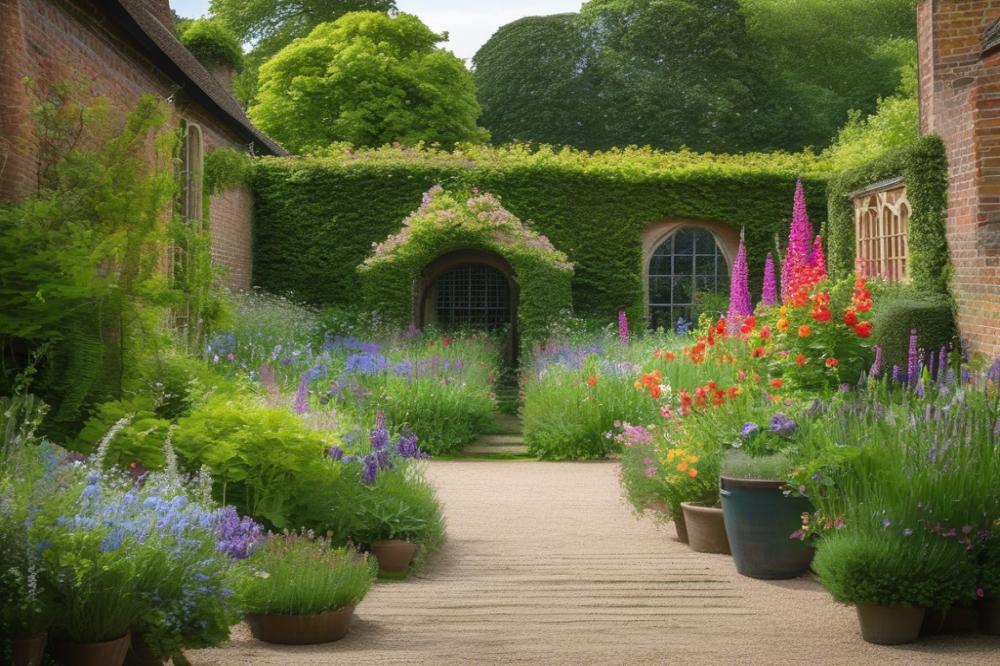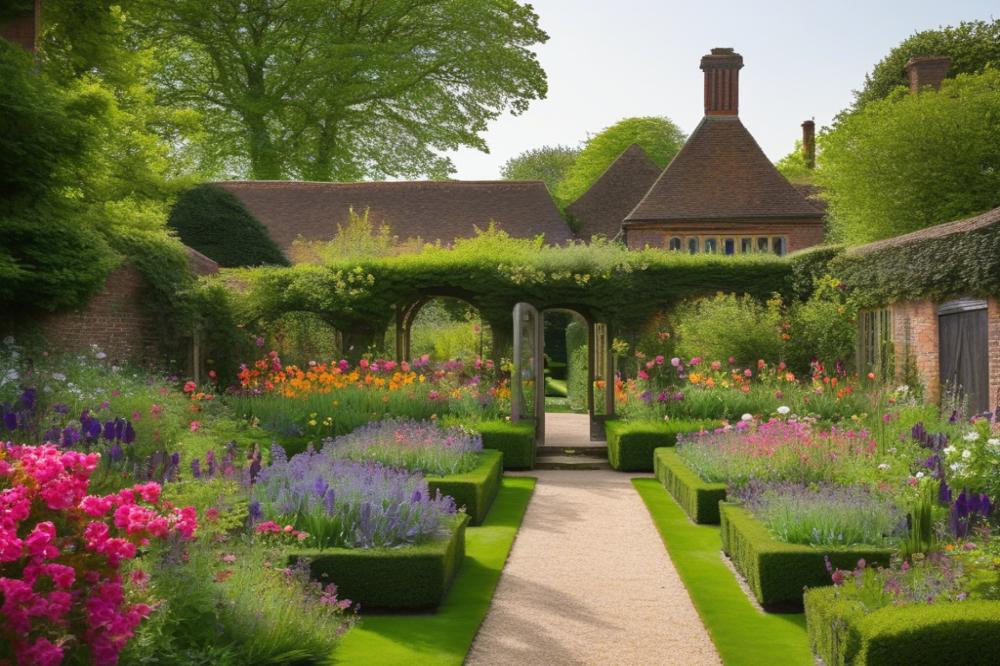The Potting Shed at Sissinghurst Castle Gardens
Overview of Sissinghurst Castle Gardens
Sissinghurst Castle Gardens is a stunning example of English garden design in the heart of Kent. This historic site welcomes visitors with its breathtaking landscapes, rich history, and vibrant collection of plants. Each section of the gardens offers a unique atmosphere, inviting guests to explore their many layers. The diversity of the plants and flowers showcases the art of horticulture at its finest.
Importance of the Potting Shed
Amid these gardens lies the Potting Shed, a pivotal element of this botanical masterpiece. It serves as a hub for gardening activities, where enthusiasts can glean invaluable gardening tips. Considered a place of both utility and inspiration, this shed holds the secrets of nurturing plants and cultivating beauty. Observing its functionality gives insight into the meticulous care that goes into maintaining the gardens.
Connection to Vita Sackville-West
Vita Sackville-West, a prominent literary figure and passionate gardener, played a key role in the creation of these gardens. Her vision transformed the grounds into a celebrated space for garden architecture and floral displays. Vita’s love for horticulture infused the Potting Shed with a sense of history that continues today. Visitors can sense her spirit; she remains an integral part of the narrative surrounding Sissinghurst. The brilliance of her designs and the personal touches she added are reflected in every corner of the garden.
History of the Potting Shed

Origins and Construction
The Potting Shed at Sissinghurst has roots dating back to the 20th century. Vita Sackville-West, a key figure in English gardening, was instrumental in its creation. Constructed in the 1930s, it reflects a blend of practicality and charm. The building features a sturdy frame and large windows, allowing natural light to illuminate the interior. This design promotes an ideal environment for plant cultivation.
Role in the Garden’s Development
As Sissinghurst’s gardens flourished, the Potting Shed played a vital part in that growth. It served as a workspace for nurturing seedlings and preparing plants for installation. In many ways, it symbolized the heart of the garden where horticulture knowledge was applied. Gardeners often shared gardening tips within its walls, fostering a spirit of collaboration. This exchange of ideas contributed significantly to the garden’s evolving design and character.
Influence of Historic Gardens in Kent
Kent is known for its rich history and remarkable gardens. The Potting Shed drew inspiration from various historic gardens in the region. Features of traditional English landscapes influenced its construction and function. Elements of garden architecture are evident in the way the shed fits seamlessly into its surroundings. Each detail showcases the blend of aesthetics and utility that defines major gardens in Kent. Thus, the Potting Shed remains a testament to the lasting impact of those historic influences.
Design and Architecture

The Potting Shed at Sissinghurst Castle Gardens stands as a thoughtful blend of function and beauty. Its design reflects the practical needs of horticulture while embracing the aesthetics of an English garden. Crafted from reclaimed materials, the structure showcases a rustic charm that complements the surrounding landscape. The use of wooden beams and large windows create a welcoming atmosphere.
Features of the Potting Shed
Inside the Potting Shed, various tools and pots are organized with care. Shelving units line the walls, displaying an array of colorful plants and gardening supplies. A potting bench invites visitors to engage with the gardening process. Natural light floods the interior, making it a bright spot for any gardener. Seasonal displays tie the shed to the rhythm of nature.
Integration with English Garden Aesthetics
This structure harmonizes beautifully with its environment. The Potting Shed enhances the overall design of the historic gardens without overpowering them. It fits seamlessly among the diverse plants that thrive nearby. Visitors often remark on how the shed captures the essence of traditional English garden design. Attention to detail ensures that its presence feels both natural and intentional.
Horticultural Techniques Used
Gardening techniques practiced here are rooted in tradition. The Potting Shed serves as a hub for learning and sharing valuable gardening tips. Many plant varieties grown within its walls reflect the rich heritage of horticulture in Kent. Visitors can observe firsthand various methods of propagation and planting. Expertise is evident at every turn, encouraging a deeper appreciation for nature and growth.
Gardening Tips from Sissinghurst

Suggestions for Handling Plants
Handling plants requires care. When repotting, choose the right size pot. Roots need room to grow. Always use fresh potting soil. Avoid disturbing roots too much; they can be delicate. Water your plants after repotting to help them settle in. Pay attention to light levels; different species need varying amounts of sunlight. Keep an eye out for pests. Prevention is easier than dealing with infestations later.
Advice on Garden Design Inspired by Sissinghurst
Garden design plays a vital role in creating a captivating English garden. Incorporate layers with various heights and textures. Vita Sackville-West believed in the power of color. Use contrasting shades for vibrant appeal. Think about pathways; they lead the eye and create structure. Consider the seasons when designing. Plants that bloom at different times will add year-round interest. Mixing perennials and annuals gives your garden life and dynamism.
Seasonal Maintenance Practices
Maintenance can differ with the seasons. In spring, focus on pruning and planting. Remove dead leaves and prepare your soil. Summer calls for regular watering. Keep track of rain patterns; hot spells can dry out gardens quickly. During autumn, collect fallen leaves. They can enrich your soil when composted. Winter demands attention too. Protect plants from frost and snowfall. Use mulch where needed to insulate roots. Staying on top of these tasks will promote healthy growth in your horticulture efforts.
Cultural Impact of the Potting Shed
Inspiration for Gardeners Worldwide
The Potting Shed serves as a symbol for gardeners across the globe. Its thoughtful design reflects the passion of Vita Sackville-West. Many visit to gather gardening tips or simply to admire the beauty of various plants. With its rustic charm, this space encourages creativity. Novices and experts alike find ideas to cultivate their own gardens. As people cultivate their yards, they often look back at this historic site for inspiration. Techniques used at the shed translate well to different environments and climates.
Influence on Contemporary Garden Architecture
Garden architecture has evolved, but the Potting Shed remains a foundational example. Its functionality highlights the importance of blending aesthetic appeal with practicality. Modern designers often draw from its’ charming layout. Features like its open windows and use of natural materials help create a welcoming atmosphere. Today’s gardens often emphasize sustainability and biodiversity, echoing principles found in this exquisite space. Visitors frequently take pictures, capturing the essence of English garden design for social media.
Recognition in Popular Culture
The Potting Shed has made appearances in various media. It captures the imagination of artists and writers alike. Many television shows showcase beautiful gardens, drawing inspiration from this Kent landmark. Books about garden design often reference its layouts or plant selections. Furthermore, the shed is also celebrated in blogs and gardening magazines. Images of this iconic spot inspire not just garden enthusiasts, but also casual viewers. Its charm continues to resonate in pop culture, reinforcing the timeless appeal of historic gardens.
Final Thoughts on the Potting Shed and Its Heritage
Summary of Sissinghurst’s Significance
The Potting Shed represents a key aspect of an important chapter in garden history. It is more than a functional space; it reflects the innovative spirit of its creator. This area invites visitors to connect with nature and the artistry that gardening entails. Every plant and tool occupies a place of meaning and purpose. A visit reveals the careful planning behind the lush surroundings.
Reflection on the Legacy of Vita Sackville-West
Vita Sackville-West, a renowned poet and novelist, left an indelible mark on gardening and landscape design. Her vision transformed the grounds into a harmonious blend of beauty and creativity. Generations of garden enthusiasts continue to draw inspiration from her work. Her passion for flora and design echoes through every corner of the garden. Visitors often feel a connection to her spirit while walking along the paths.
Encouragement for Visiting and Experiencing Sissinghurst
Visiting this historic site promises an enriching experience. Exploring the meticulously crafted spaces stirs a sense of wonder. Engaging with the flora lets visitors appreciate the art of gardening firsthand. Each corner reveals new details that spark curiosity and reflection. Local guides often share stories that bring the location to life. Do not miss the opportunity to see this exceptional treasure. Embrace the serenity and inspiration that the Gardens offer as a lasting gift to all who explore them.



